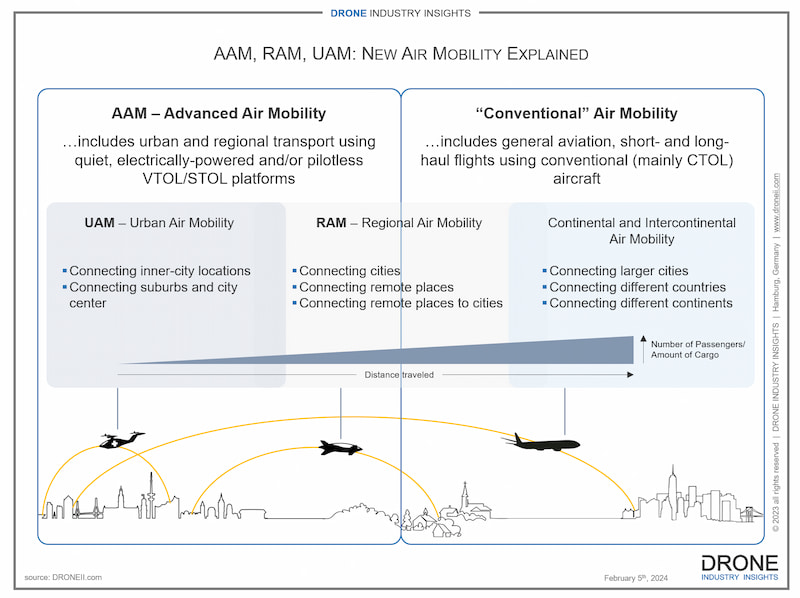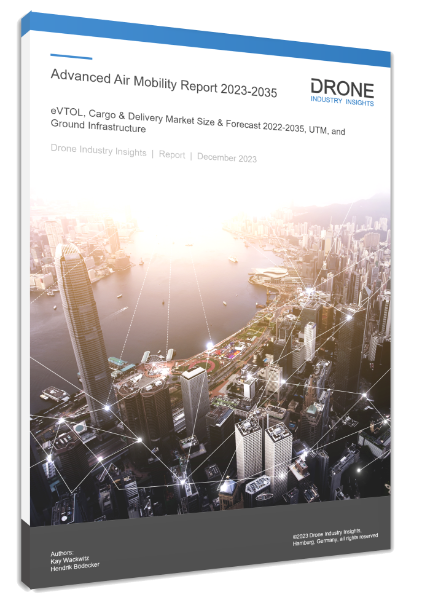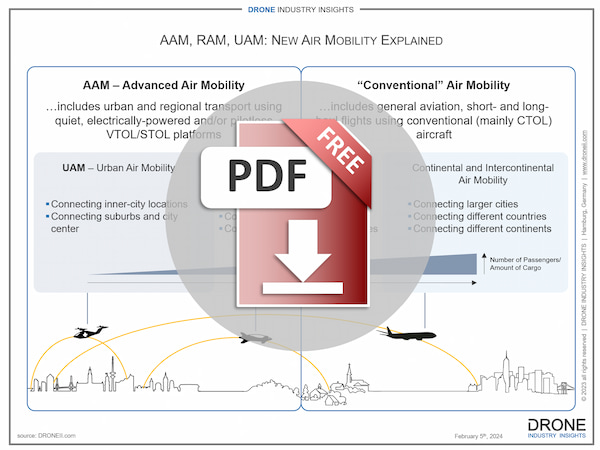

The Future of Transportation: What is Advanced, Regional, and Urban Air Mobility?
The previous article about Advanced Air Mobility (AAM) stated that AAM is an overarching term that combines both Urban Air Mobility (UAM) and Regional Air Mobility (RAM). And yet, this doesn’t truly do justice to the innovation and transformation that comes with both UAM and RAM. Therefore, this latest installment about AAM will elaborate more on the overlap and differences between UAM, RAM, and AAM. All three of these terms about the future of [air] mobility will have a similar-yet-varying impact on cities, suburbs, and the countryside, not to mention on aviation as a whole.
What is Urban Air Mobility (UAM)?
Oftentimes, people will use the term UAM when in fact they are referring to something closer to AAM (and vice versa). Urban Air Mobility (UAM) includes traffic within a city as well as commuting from the outskirts. Today, this kind of transportation is carried out mainly by cars, motorcycles, and buses, leading to traffic jams, delays, and a lot of headaches for many people.
Ultimately, the promise of Urban Air Mobility is irresistible: clean, cheap air transportation, instantly summoned with the tap of a finger on a smartphone. That is the vision that is fueling a worldwide boom in electric vertical takeoff and landing (eVTOL) prototypes, with new aircraft emerging from hangars and press releases seemingly every month. The vision to fly above these traffic jams in a quick and ecologically friendly pod is tempting and one of the main drivers for this industry. It includes airport shuttles, medical transports, commuter traffic, individual (taxi-like) transportation, as well as cargo/delivery. It is also appealing for cities that are separated by a river, mountains, or spread across islands.
And this promise of efficiency doesn’t end with the transport of people. Logistics – both Hub-to-Hub, as well as first and last-mile delivery – have a great interest in shipping goods quicker, at lower costs, and with a smaller ecological footprint. Using fully-automated platforms to connect fulfillment centers up to end clients, is an almost too-good-to-be-true scenario, which further fuels this vision of UAM (as well as the billions worth of investments going into it).
What is Regional Air Mobility (RAM)?
Perhaps the least-used and most confused term in this group is Regional Air Mobility (RAM). On the one hand, many people will primarily understand RAM as a computer-related term (random access memory). On the other hand, even within air mobility, it is not often clear if RAM is being used for Regional Air Mobility or Rural Air Mobility. Although there is technically no correct or incorrect meaning of RAM, the meaning Regional Air Mobility is perhaps the most useful for connecting UAM with a broader region that expands beyond suburbs and to rural areas. After all, the chances are not high that someone would want to talk about a “rural air mobility” that excludes suburbs and cities.
Beyond the urban centers of UAM, there are also villages, small towns in the countryside, islands, and municipalities separated by wide rivers, high mountains, and dense forests. These locations are not far enough for a plane to properly take off and reach cruising altitude, yet also not close enough to simply “take an air taxi” from vertiport to vertiport. And this is precisely where Regional Air Mobility will thrive and offer a solution that currently only helicopters and small planes can match.
Currently, helicopters offer limited capacity (for both persons and cargo) with distinctly high emissions (in terms of both noise levels and fuel). Meanwhile, small planes still require runways and carbon fuels that eVTOLs and other passenger drones promise to eliminate. Therefore, it is perhaps here in the least common air mobility term that new technologies are likely to make the most noticeable impact. After all, there are already other vehicles providing transport for short distances (e.g. cars, trains, and buses) as well as for long distances (e.g. conventional airplanes).
Among the best examples of regional transportation and RAM is Lilium’s plan to connect airports in the Bavarian cities of Munich and Nuremberg, as well as projects to connect islands in Greece or the Maldives.
Want to Know More About Advanced Air Mobility? Check Out Our New AAM Report!
Advanced Air Mobility (AAM) Report 2022-2035
• Extensive 129-page Advanced Air Mobility Report with in-depth analysis and information
• Air taxis/eVTOLs/Passenger Drones
• Delivery/Cargo Drones
• Vertiports
• UTM
• Exclusive data on market size derived specifically for the Advanced Air Mobility Report
What is Advanced Air Mobility (AAM)?
Finally, we turn our attention to the broader term of Advanced Air Mobility (AAM). In essence, Advanced Air Mobility refers more generally to a new mode of transportation that uses relatively quiet, electrically powered, and potentially autonomous platforms (regardless of use within or outside of a city center). As mentioned previously, AAM encompasses both aforementioned topics of UAM and AAM. The integration of AAM into communities (both urban and rural) and their current infrastructures typically pivots around four major points.
The first is safety and security: Just like small drones, large eVTOLs must prove their technical and operational safety and security. The second is the public benefit: in addition to emergency services, increased travel options, and potentially reduced ground traffic, AAM also provides new economic opportunities and more connection to rural areas as well as “transportation deserts”, among other additional benefits. Thirdly, there are adverse impacts such as visual and acoustic pollution, privacy concerns, increased traffic over residential areas, and the fear that the technology will only be available to a limited segment of the population. Lastly, there is integration: the goal of AAM integration must be creating options to provide “urgent travel” and to consider the existing transportation landscape (e.g. over- or underserved areas), general accessibility, grid capacity, and social equity.
UAM, RAM, and AAM: Air Mobility and the Future
Whether it is UAM or RAM, the two biggest markets for the new air mobility solutions are passenger transportation (e.g. for commuting, tourism, major events, and sightseeing) and cargo transport (e.g. for urban & regional delivery). For both markets, AAM has the potential to revolutionize urban and regional transport through reduced travel times and improved mobility options. In addition, the industry can be scaled with relatively small amounts of capital compared to other more asset-intensive transport alternatives such as roads, airports, waterways, or train tracks.
The possible applications for AAM are far-reaching. This reach extends not only geographically but also chronologically. That is: AAM will have a lasting impact not only on the way we move around urban and regional space but also on the way we move around in the future.
Download our FREE Air Mobility Infographic
The “Air Mobility Infographic” provides a simple and easy-to-understand overview of the key terms in the future of air mobility (AAM, UAM, RAM) as well as conventional air mobility.

Before working with drones, Ed acquired vast experience in Communications and Diplomacy. He holds a Master’s in International Relations, Bachelor’s in Economics & Philosophy, and has lived in 7 countries.



